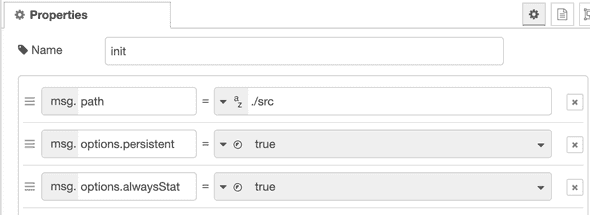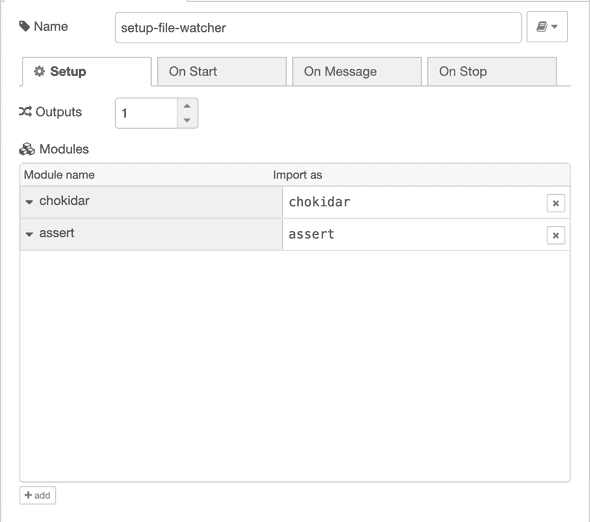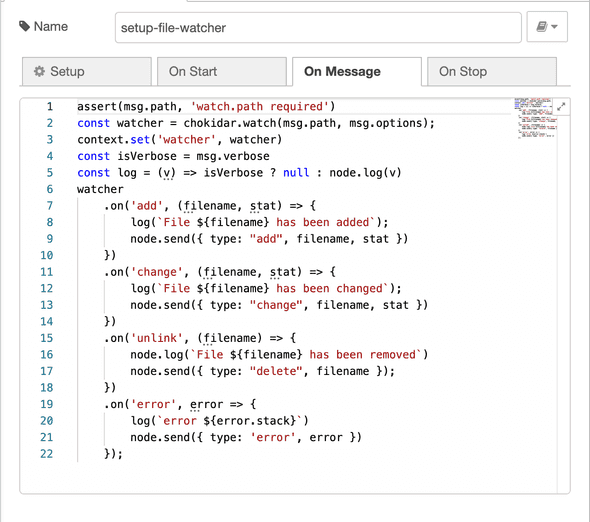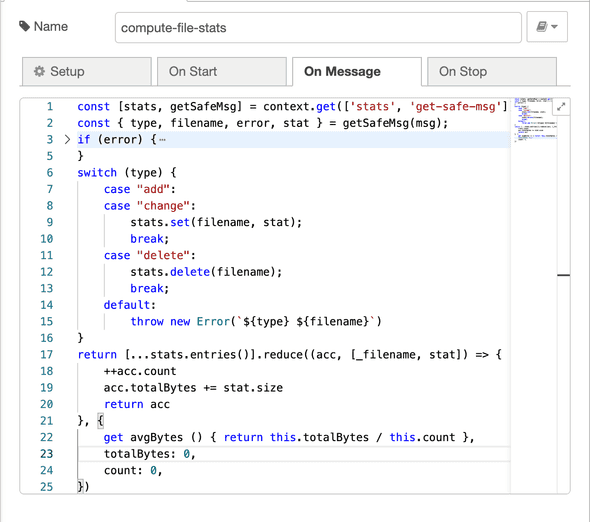
cdaringe
learnings, nerdisms, bicycles
about
rad
freshawair
up'n'up
pl selector
dvd.js.org
standup
donut
cowtown
truth.lol
fish.js.org
factorio-type-kit☠
red-or-green☠
senor-salsa☠
On General Purpose VPL Viability: Filesystem Watcher Stats
May 7, 2022
Context
I have long been interested in the viability of visual programming languages (VPLs) for general purpose programming. VPLs tend to be domain specific, most often in hardware space. There has been a recent flurry of fresh activity in this old topic, so I want to make a fresh re-assessment.
Evaluation Criteria
Comparing my VPL of choice to well known general purpose programming languages du jour:
- Can architecture be easier to learn or convey?
- Can contributions be made more safely to the application or library?
- Can the testing UX be improved?
- Can iteration speed or ease be improved?
- What orthogonal threats are introduced?
- What orthogonal benefits are introduced?
Some of these inquires are direct proxies to "can net quality be improved" which is certainly a question I want to answer as well. However, I am interested in the minutia, the UX, the feeling, and both the literal and perceived sense of robustness when trading traditional programming languages for a VPL.
Experimental Tooling
There are two VPLs that I think are currently worthy of evaluation:
- enso
- I did not select enso due to:
- You must login to use the editor. This removes its general viability somewhat extensively.
- It has done >6 months without a release
- These two signals told me this tool (perhaps amazing tool) is not yet ready for primetime. I value trying out bleeding edge tools, but I am in search of proper viability, which mandates some modicum of stability.
- I did not select enso due to:
- node-red
Let us select node-red. node-red is a good candidate because it is under
continuous active development, has extensive documentation, and seems to exhibit
a sound balance of high capability with good UX. If you can the VPL wiki and
read the many HackerNews threads, you can observe that few tools are actually
mature enough for general purpose programming, let alone those which you would
actively deploy into production.
Experiment
Filesystem Watcher Stats
Objective: write a program that reads a directory recursively, watches it, and continuously emits stats about the directory. Let's just include:
- count of files
- cumulative size of all files (bytes)
- avg file size
It turns out, node-red already offers a FS watcher out of the box, albeit less powerful. I was not aware! Nonetheless, here is the whole program:

It's a simple program, by design. Even so, wiring up a watcher and computing derived state from a stream of file-stat messages could be argued as non-trivial. The flow of this diagram does make this application look quite trivial, which is an interesting observation on its own.
The first node is an Inject node name init. I probably should have named
this step emit-configuration. This node is immediately emits on program start.
If we were writing an imperative program, this step would be implicit.
Nonetheless, the setup that I author in the init step would be multi-line, and
perhaps not so clearly grouped/encapsulated were it in, say, a bash program.
If I pop open the config, you'll see:

I have hard coded these values, but they certainly could have been read from
config, a message, or the environment. These msg values are
chokidar.watch params.
The init node sends a config message into a function node named
setup-file-watcher. It would be interesting to write the file watcher from
scratch, but x-platform filesystem watchers are known finicky to author.
The setup-file-watcher is somewhat interesting, as it demonstrates:
- tapping into the programming environment when users want to drop out of the VPL
- modular design in the VPL
Let's jump into a few tabs in the setup-file-watcher node.
I need a few libraries. node-red makes importing and exposing them trivial.

chokidar is a node.js file watching utility. assert is the node.js builtin
assertion library.

Next up, On Message. In the current state, I expect only one config message,
thus setup a file watcher as a singleton for the node. However, this could be
minimally tweaked to permit many file watchers created from many messages. I
bind the file-watcher instance (chokidar instance) to events, mapping them back
to the VPL via node.send(...) calls. This is great--I love the concept of
node.send(...) invocations sending messages through the rest of my node-red
flow. Additionally, I set some node level state, which allows me to clean up
the memory and teardown the watcher when my program exits.

The final interesting part of the application is a compute-file-stats function
node. Again, I use the function type node. This node:
- instantiates some persistent node state, mapping a
filenamestring tofs.Statinstance - processes many messages, where
- each message mutates the mapping and emits an updated stat aggregate


You may be thinking "that's a lot of JavaScript, not using VPL tools" to compute the file statistic message. You're right. Put a pin in that thought, and we'll come back.
Finally, we plumb the statistic message from the compute-file-stats node into
a debug node, just so we can pretty print our messages somewhere.
From node-red, I can hit the Deploy button. Now, I can start adding,
changing, and deleting files in my watched folder, and observe realtime outputs.
Revisiting the "not using VPL tools" discussion. We wrote our full stats
reduction in JavaScript, versus using any VPL reduction primitives. node-red
does not offer a great mechanism to actually do lower level data processing
outside of JavaScript. Its strength is more in passing the datas along to macro
processing units. Due to no support of multiple inputs, implementing a something
as simple as a map-reduce with their VPL constructs is quite cumbersome. I
created a
successful proof of concept, and some of the community also pitched their ideas
in on the node-red forum. So, it's achievable, but the complexity it adds may
diminish its practical value.
Evaluation
Q: Can architecture be easier to learn or convey?
Absolutely. The visual nature of the design, and the ability to link in subflows are very powerful. Rather than jumping through flat files, the flow modularized the relevant code, field, and general data in logical, named buckets that had clear association with a step in the flow. The step in the flow was self evident by means of association with edges between nodes, as opposed to imported modules commonly used by popular programming languages.
Can contributions be made more safely to the application or library?
Unlikely.
There is no visual-VCS tooling in this space at the moment. node-red
collaborators would be studying diffs of JSON files, which is worse than
studying code, as you are study serialized code, versus code itself.
Furthermore, conflicts would be frequent in a team of multiple contributors
working on the same segments of the application.
Can the testing UX be improved?
Maybe. The node-red forums have various users discussing this. There are no
best-known-methods or patterns in place. However, some simple patterns could be
thought up to make this a possibility. I'm quite confident that by practicing a
few conventions around the application's configuration model and the way
Inject nodes are used at the beginning of flows, an interesting and powerful
integration testing mechanism could be blissfully developed. I halted exploring
this deeply, due to lack of ability to execute map-reduce visually with
elegance.
Can iteration speed or ease be improved?
Unknown. Without the testing story flushed out, it is too hard to tell. A professional iteration cycle requires both a good development story and a good testing story. The development story has strong traits, namely around encapsulation and clean coupling, but is missing strong traits like strong typing, inference, etc.
What orthogonal threats/benefits are introduced?
Skipped, for the same reason iteration evaluation speed evaluation was skipped.
What's next?
Repeat the experiment in enso!